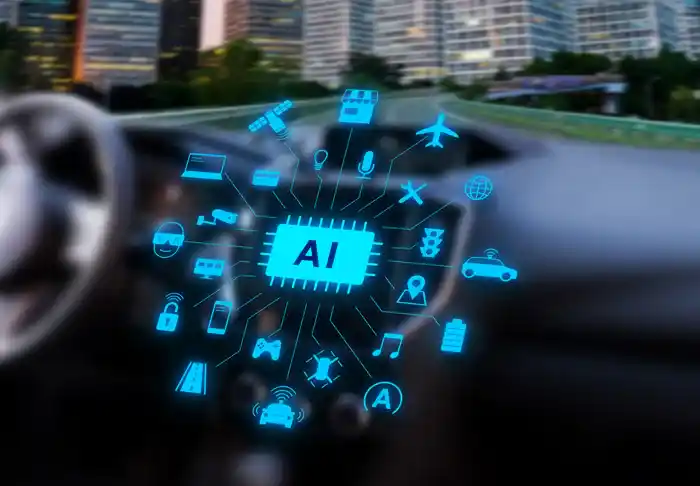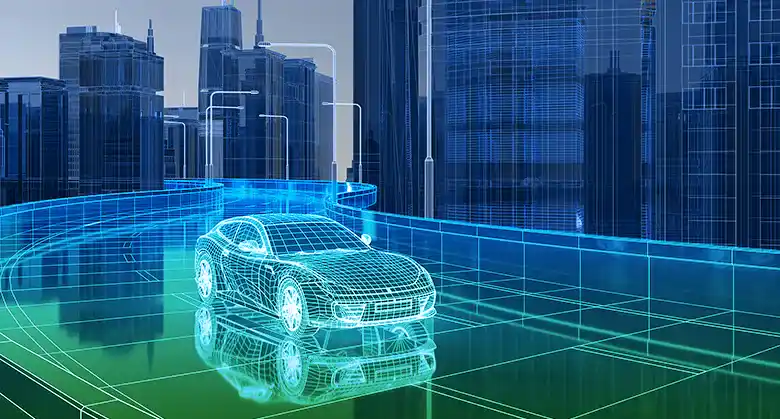Table of Contents
The integration of AI in transportation is transforming the way people and goods move across the world. From improving safety and efficiency to reducing environmental impact, AI has become a critical component in modernizing transportation systems. This revolution is not only reshaping urban mobility but also the logistics, freight, and aviation sectors.
10 Applications of AI in Transportation
In this article, the focus will be on 10 powerful applications of AI in transportation that are driving this transformation.

1. Autonomous Vehicles
Autonomous vehicles, or self-driving cars, are one of the most prominent applications of AI in transportation. AI systems use machine learning, computer vision, and sensor fusion to enable vehicles to navigate roads, recognize obstacles, and make decisions in real time.
Companies like Tesla, Waymo, and Uber are at the forefront of developing fully autonomous vehicles. AI in transportation has made self-driving cars safer by reducing the likelihood of human error, which is a leading cause of accidents. In the UK, autonomous vehicles (AVs) are set to be deployed in 2025, with major companies like Tesla already conducting nationwide testing programs. These vehicles are expected to reduce congestion, improve fuel efficiency, and lower emissions.
2. Traffic Management and Prediction
A major issue in urban regions is the problem of traffic congestion. AI in transportation is being used to improve traffic management systems, helping to reduce congestion and optimize traffic flow. AI algorithms can analyze real-time traffic data from sensors, cameras, and GPS devices to predict traffic patterns and adjust traffic signals accordingly.
AI reduces travel time, fuel consumption, and emissions by predicting and managing traffic flows more effectively. Cities like Los Angeles, London, and Singapore are already leveraging AI-based traffic management systems to improve urban mobility.
3. Predictive Maintenance for Vehicles
AI is revolutionizing vehicle maintenance through predictive analytics. Collaborating with specialized automotive software engineering services can accelerate the integration of advanced AI features, ensuring efficient and reliable transportation solutions. In transportation, AI can monitor vehicle health using sensors and onboard diagnostics. It analyzes data to predict when a vehicle might need maintenance, thereby preventing breakdowns and reducing downtime. Predictive maintenance is widely used in public transportation fleets, logistics companies, and aviation.
For instance, airlines use AI to predict when aircraft components might fail, enabling them to perform maintenance before a critical issue arises. This application of AI in transportation improves safety, reduces costs, and increases operational efficiency.
4. Smart Public Transportation
AI in transportation is enhancing public transit systems by improving efficiency and customer experience. Through the analysis of passenger data, AI can optimize bus, train, and subway schedules to meet demand, reduce wait times, and streamline routes.
AI-powered chatbots and mobile apps provide real-time information on transit schedules, delays, and crowding levels. In cities like London, New York, and Tokyo, AI is being used to predict passenger flows and adjust services accordingly.
By making public transportation more reliable and user-friendly, AI is encouraging more people to use it, thus reducing congestion and emissions.
5. AI-Powered Route Optimization

In logistics and freight transportation, AI is being used to optimize routes for delivery trucks, ships, and airplanes. AI in transportation allows companies to analyze various factors such as traffic conditions, weather patterns, and fuel consumption to determine the most efficient routes. This optimization not only saves time and fuel but also reduces operational costs.
Companies like UPS and FedEx have implemented AI-powered route optimization systems to improve delivery times and reduce emissions. This technology is particularly valuable for long-haul transportation, where fuel efficiency and timely deliveries are critical.
6. AI-Enhanced Safety Systems
AI is making transportation systems safer by improving collision detection, driver assistance systems, and vehicle-to-everything (V2X) communication. In autonomous and semi-autonomous vehicles, AI can identify and react to potential hazards faster than a human driver.
Advanced driver-assistance systems (ADAS) like automatic emergency braking, lane-keeping assistance, and blind-spot detection are all powered by AI. These systems significantly reduce the risk of accidents and improve road safety. AI-enhanced safety systems are being widely adopted in cars, trucks, and even bicycles, making transportation safer for everyone.
7. Intelligent Infrastructure Monitoring
AI in transportation extends beyond vehicles; it also plays a significant role in monitoring and maintaining infrastructure. AI-powered sensors and drones are used to inspect bridges, tunnels, and highways for wear and tear, cracks, and other signs of deterioration.
By analyzing data from these sensors, AI can predict when repairs are needed and help prioritize maintenance tasks. This proactive approach to infrastructure maintenance prevents costly repairs and ensures the safety and reliability of transportation networks. Governments and transportation authorities are increasingly investing in AI to monitor and maintain infrastructure more efficiently.
8. Platooning of Autonomous Trucks
Platooning is an innovative concept in freight transportation where multiple trucks drive in a closely-knit convoy, with only the lead truck being manually controlled while the others follow autonomously. AI in transportation enables autonomous trucks to communicate with each other, ensuring that they maintain a safe distance and react to changes in the environment.
Platooning improves fuel efficiency, reduces traffic congestion, and lowers emissions. Several companies, including Peloton Technology and Daimler, are developing AI-powered platooning systems that are set to revolutionize the trucking industry.
9. AI-Driven Demand Forecasting
AI in transportation is also being used for demand forecasting, which is essential for both public and private transportation sectors. AI algorithms analyze historical data, seasonal trends, and real-time factors like weather conditions and events to predict future demand. This allows transportation companies to adjust capacity, routes, and schedules to meet fluctuating demand levels.
For example, ride-hailing services like Uber and Lyft use AI-driven demand forecasting to optimize pricing and availability during peak hours. Similarly, airlines use AI to predict passenger numbers and adjust flights accordingly, improving operational efficiency and customer satisfaction.
10. Electric and Autonomous Drones

Drones are increasingly being used in transportation for delivering goods, especially in remote and hard-to-reach areas. AI in transportation is powering autonomous drones to carry out deliveries without human intervention. These drones use AI to navigate obstacles, avoid collisions, and optimize flight paths for energy efficiency. Companies like Amazon and Zipline are utilizing AI-powered drones for delivering packages and medical supplies.
AI is also being used to monitor the health and performance of drones, ensuring that they operate safely and efficiently. The use of AI in drone transportation is expected to grow significantly in the coming years, offering faster and more sustainable delivery solutions.
Conclusion
AI in transportation is driving significant advancements in how people and goods move across the world. From autonomous vehicles and predictive maintenance to AI-enhanced safety systems and intelligent infrastructure monitoring, the applications of AI are vast and varied. These technologies are not only improving the efficiency and safety of transportation systems but also reducing environmental impact.
As AI continues to evolve, it will play an even greater role in transforming transportation, making it smarter, more sustainable, and more accessible. The integration of AI in transportation is no longer a futuristic concept but a present-day reality that is reshaping the industry for the better.